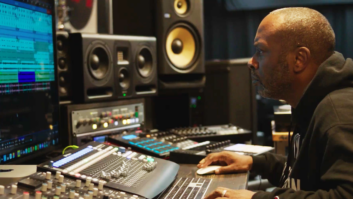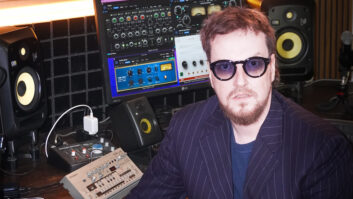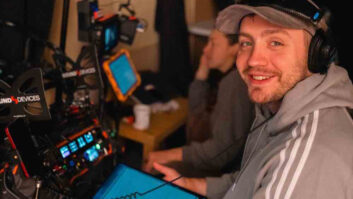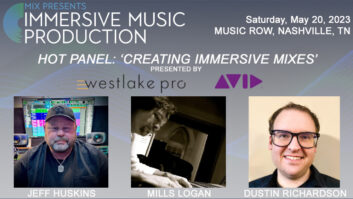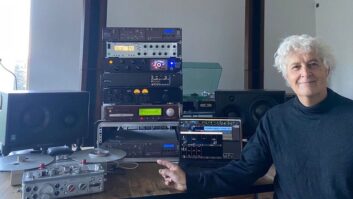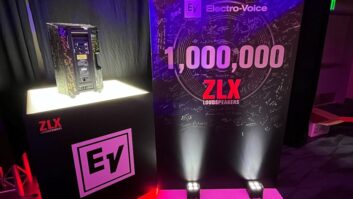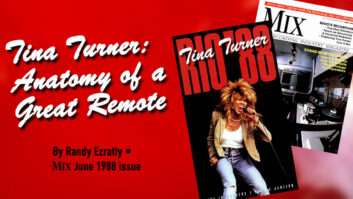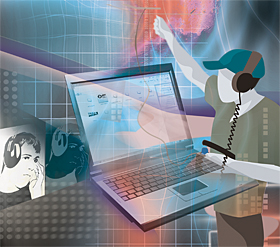
Portable production has been evolving steadily in the past three decades:. In the early days, there was the need to transport large-format digital and analog multitrack machines, mixers and the copper cable necessary to make it all work together. The landmark release of the Alesis ADAT in the early ’90s took quality, convenience and affordability to a whole new level: Not only was quality multitrack digital recording technology suddenly within the reach of everyday engineers, it came in a rackmountable, modular format that was easily and inexpensively set up and shipped. The possibilities for remote operation were expanding. But the real shift came in early 2000, when engineers started truly embracing computer technology, trusting DAWs, interfaces, converters and plug-ins as convenient and reliable road gear. Today’s affordable and portable technology lets engineers take an entire studio on the road, whether the rig is a simple laptop and headphone setup for tracking and editing, or one that incorporates portable interfaces, MADI converters, speakers and even small trucks for producing and recording music for live feeds, streaming or distribution.
Although traditional brick-and-mortar studios have been hurt by the ease and low cost of remote production, they have also adapted by working with producers who use portable rigs, adding special touches that can’t be achieved in the field. For instance, bandmembers who want to take their time doing vocals at home might use a larger facility to record drums in a well-isolated room with a good ambient signature. The outcome is a broader palette of production styles, gear choices and flavors of output, whether producing for live broadcast, the Web, CD/DVD release or remote recording. We talked with a cross-section of nomadic engineers, musicians and music creators who have adapted to the new production model.
Regional Production
Michael Comstock’s Indre Recording and Production (www.indre.com), located just outside of Philadelphia, is a case study in adapting a successful business model to new technologies. Indre started as a traditional recording studio in 1996 and eventually evolved into a thriving remote production business.
“When I started, bands would come in with $4,000 to do their record,” Comstock says. “Now that same band will take that money and buy Pro Tools [systems], mics and preamps to make their own studio.” In 2006, Comstock converted his business into a 100-percent mobile model and never looked back. Indre has an upscale client base, and its projects include a Harry Connick Jr. Christmas special for AOL Music and live concert broadcasts of My Morning Jacket and The Decemberists for NPR.
Indre’s business revolves around a small production truck housing a Yamaha 02R96 digital console, Apogee Big Ben Master Clock, Pro Tools HD3 (80 channels), Apple Logic Pro Version 8 (64 channels), Genelec 1031A monitors and a digital signal flow from the stage. “MADI has changed how we record remotely,” says Comstock. “It is easy to run, supports an amazing amount of data and eliminates any ground or RF issues with the venue.” The feed to Indre’s truck starts from the stage, with Radial OX8 three-way splitters feeding eight PreSonus DigiMax LT preamps offering 56 total channels. The DigiMax LTs’ optical outputs feed an RME ADI-648 ADAT/MADI converter that then takes the signal to the truck. Once in the mobile studio, the signal feeds an RME MADI router to the console, then Pro Tools and Logic 8 for redundant recording. When the truck is not an option, Indre uses “flypacks” comprising dual Pro Tools HD3 systems stored in flight cases.
The call for processing depends on the job. “I’ll use some processing for a live broadcast, but for the most part keep it simple for a straight recording.” When tracks call for on-site sweetening, Comstock turns to some plug-ins, but mostly relies on the EQ and dynamics built into his Yamaha 02R96. “It’s great to have the hands-on feel of the console when we’re live at the venue,” he says.
Out of Africa
Engineer Michael Gassert’s work spans from traditional studio work at Mix B in New York City, which he co-founded, to remote work with Bachir Attar & Master Musicians of Jajouka (www.jajouka.com), an ancient village in the blue Djebala foothills of the Rif mountains in northern Morocco. Brian Jones of the Rolling Stones was the first to record the group in 1968. Gassert says, “I have done several recordings with them on tour and in the village over the last three years. We are releasing our first record together and their first in almost a decade, recorded live in Lisbon.”
Gassert tracks on a MacBook Pro running MOTU’s Digital Performer. He uses Metric Halo Mobile I/O 2882+DSP converters, as well as custom-built Neve and API clone preamps into an RME Fireface 800 that’s ported into his Mac G4 laptop. For the front end, he uses a variety of mics from Schoeps, plus Sennheiser RE20s, 421s and 441s; AKG C 1000s and 414s; and Neumann TLM193s.
For the finished product, Gassert starts with some remote editing and reference mixes for the band, which he sweetens in the field using Waves Diamond Bundle plug-ins and ambience from the Audio Ease Altiverb convolution reverb plug-in. He then takes it back to Mix B for the final touches, using a combination of the previously mentioned plug-ins and outboard gear. “I’ll generally warm things up with a Culture Vulture [from Thermionic Culture] and the Avalon 747VT compressor/EQ, or sometimes I’ll use our Eventide H8000 for effects or even our Fulltone tap-tube echo,” he says. To get from the outboard gear back to Digital Performer, Gassert uses Apogee converters or sums it through an Allen & Heath GS3000 mixer.
Rockin’ the Laptop
Los Angeles-based band Hillbilly Herald (www.hillbillyherald.com) comprises Jimmy Herald (vocals), Mark Hill (guitar), Adam Wolf (bass) and Kyle Cunningham (drums). The band has embraced the “less-is-more” production standard for reasons of both quality and cost. “You can record now virtually for nothing,” says Herald about the upside of recording outside a studio. “You can be creative without having to spend millions of dollars and get your product out there.”
For writing and laying tracks for final mixing, Herald and Hill use a 2.2GHz Apple MacBook Intel Core Duo with 1 GB of RAM, an Apogee Duet interface and a Shure Beta 87C into Apple’s GarageBand and Logic Pro. Hill likes the simplicity of the Duet: “The fewer the cables, the better,” he says. “It’s the kind of thing you want to set up quickly, whether it’s a rehearsal or in someone’s apartment.”
Hill’s background in music and recording was formed at various studios in Austin. “I used to be a huge Pro Tools guy, but I made the switch to Logic in the past year,” he says. “It was a hard thing for me to do, but I think Pro Tools has fallen a bit behind.” It’s important to him that the same company that makes his computer also makes his DAW, which allows for quick software updates without worrying about operating system compatibility.
The production process begins with writer/singer Jimmy Herald laying down rudimentary bass parts into GarageBand to an Apple Loop of a rock drum kit. Once the song structure is figured out and basic guitars and vocals are recorded, Hill imports the tracks into Logic Pro and then uses Toontrack’s Superior Drummer 2 to program a detailed drum track. From there, he plugs his guitar directly into an Apogee Duet and uses either Logic’s built-in amp simulator or Overloud’s TH1 guitar amp simulator plug-in to prepare the track for live drums.
The band cuts drums at either Entourage Studios in North Hollywood or in Los Angeles at Bryan Carlstrom’s Transformer studio, after which the tracks return to the portable rig at home for adding further vocals, guitars and other overdubs. The band takes advantage of Logic’s presets to get the tracks sounding the best they can with their limited resources.
“You don’t have to waste time,” says Hill. “Logic has a lot of great presets for vocals that may not be the best of the best, but it’s perfect for songwriting or putting together the record before the mix.” The finished tracks then get mixed and mastered by Carlstrom, who imports the raw tracks into Pro Tools and starts mixing from scratch. Hill adds, “I’ve worked in a lot of studios, and I can’t believe what you can do now with just a few things — and you can get it sounding really great.”
New York State of Recording
New York drummer Billy Ward (www.billyward.com) has played with such notable artists as Joan Osborne, Carly Simon, Robbie Robertson, Bill Evans and B.B. King, and is no stranger to affordable portable production. Ward recorded his own CDs, Two Hands Clapping and Out the Door, using a minimal rig, and recently created two new audio and video collections from the Billy Ward Trio for release on the Web. The trio comprises Ward, L.A. guitarist/composer Barry Coates and Boston bass player Bill Urmson; all three gathered at Ward’s lake house in upstate New York for rehearsals in preparation for a live gig at Manhattan’s Cutting Room.
“We met at the house and for a couple hours each day we played in the living room,” says Ward about the rehearsals. “We just set up a pair of Schoeps CMC 41 mics through Chand-ler TG2 preamps through an Apogee Duet into Logic on a laptop.” The band had no inkling that their rehearsal tracks would ever go public, but the results were so good that Ward decided to release them on his Website in a “pay what you want” format. “The house has wooden floors with bare walls, save for artwork, so it is not a room designed to sound good. I just want to acknowledge that sometimes the music can overtake obstacles.”
Following the rehearsals, the trio performed and recorded at the Cutting Room. A four-camera, two-person video crew captured the event live, along with Robert L. Smith from Defy Recordings, who recorded to Pro Tools. The audio setup at the club was small, using four mics — two Schoeps CMC 41s and two modified large-diaphragm Oktava mics — into Chandler TG2 and API preamps, then ported into the computer using an Edirol interface. The Oktavas were placed close to the stage in a coincident pair facing the band, while the Schoeps CMC 41 hypercardioid mics were in the back of the room in another stereo pair facing the stage. Ward also employed the venue’s live sound engineer, who recorded his stage mic feeds onto two tracks for added coverage, giving him a total of three stereo feeds.
After the gig, Ward sweetened and prepared the recorded tracks for download back at his home studio. “I laid all six of the tracks into Pro Tools and each one had some qualities,” says Ward. “The Schoeps, even though they were 40 feet from the stage, had such a sweet top end, yet there was way too much detail in audio noise.” Ward started the mix with the closer-placed Oktavas, then added the Schoeps to the mix only after using a low-cut filter set at a relatively high frequency. “I used this to get the icing on the sonic cake and carefully blended it in.” Ward also added some low frequencies to the Oktavas, experimenting with various scenarios using Daking EQs. He also brought up some of the quieter passages in the mix. “You still hear the [band’s] dynamics, but it’s not like the floor falls out,” he comments. He then handed off the audio to video editor Neil Miller, who edited and synched the video and audio tracks for the final release.
It’s a Wrap
The juxtaposition of affordable, computer-based digital audio workstations with shrinking budgets, along with reliable, cheap new distribution methods have revolutionized the ways music is being made. And as we’ve seen from the examples above, audio pros have responded by using these new tools to forge successful models for production while maintaining quality.
Kevin Becka is Mix‘s technical editor.
